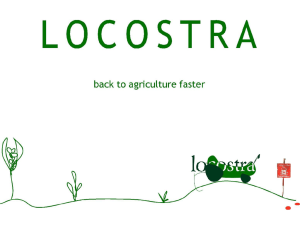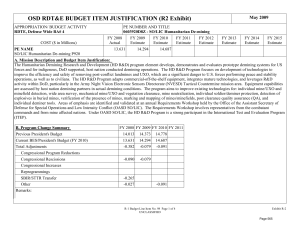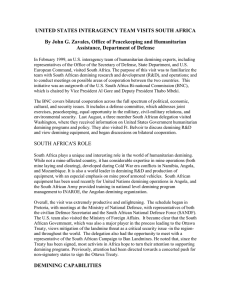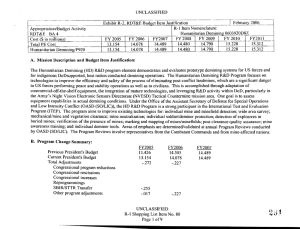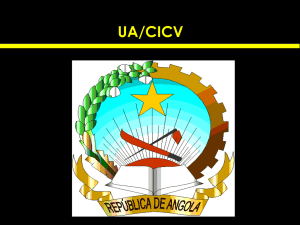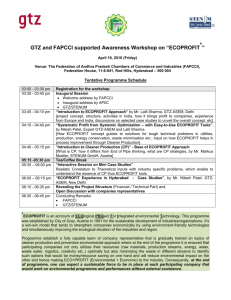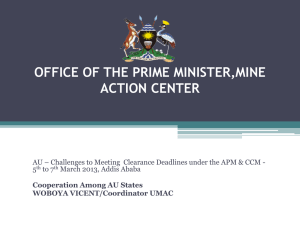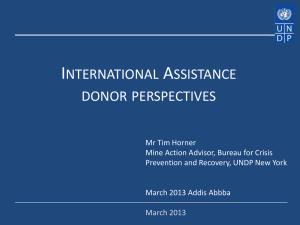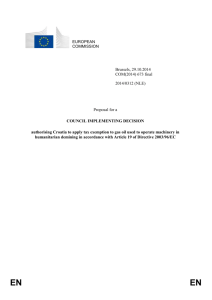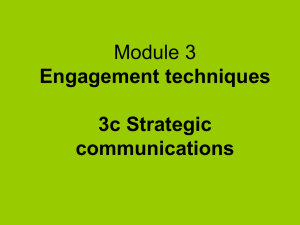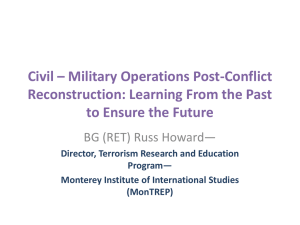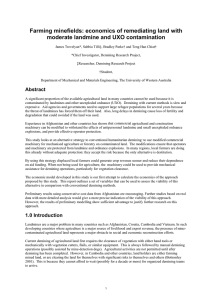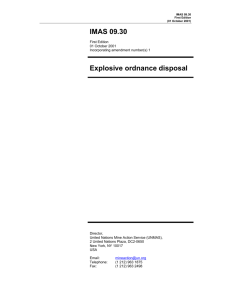gtz_hoffman
advertisement
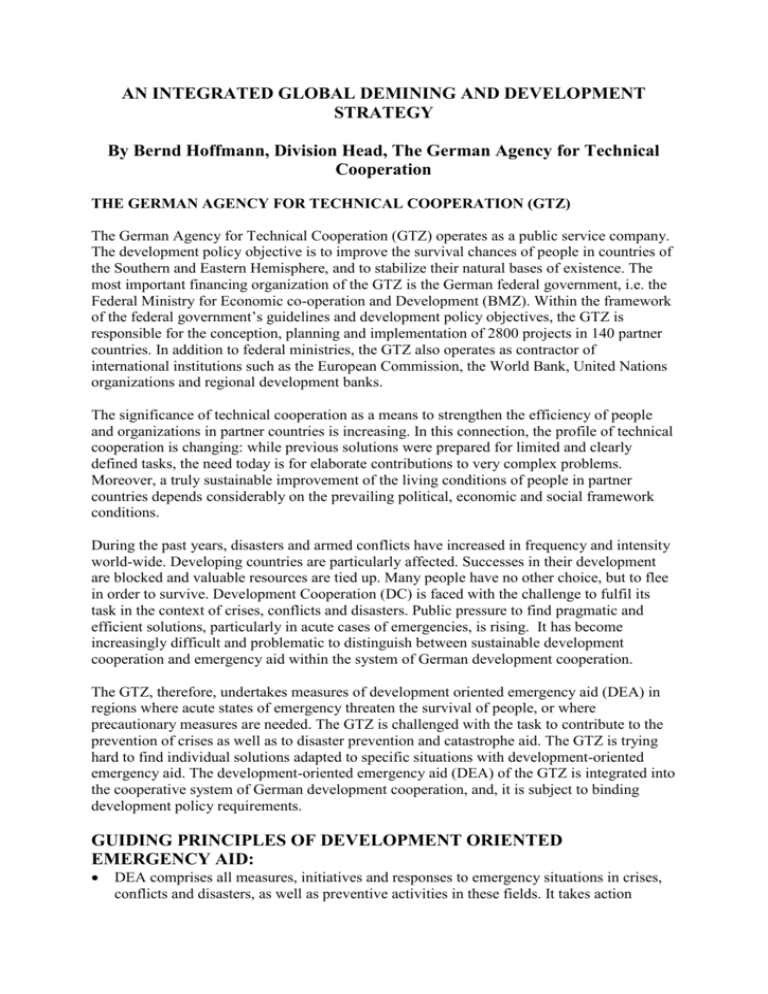
AN INTEGRATED GLOBAL DEMINING AND DEVELOPMENT STRATEGY By Bernd Hoffmann, Division Head, The German Agency for Technical Cooperation THE GERMAN AGENCY FOR TECHNICAL COOPERATION (GTZ) The German Agency for Technical Cooperation (GTZ) operates as a public service company. The development policy objective is to improve the survival chances of people in countries of the Southern and Eastern Hemisphere, and to stabilize their natural bases of existence. The most important financing organization of the GTZ is the German federal government, i.e. the Federal Ministry for Economic co-operation and Development (BMZ). Within the framework of the federal government’s guidelines and development policy objectives, the GTZ is responsible for the conception, planning and implementation of 2800 projects in 140 partner countries. In addition to federal ministries, the GTZ also operates as contractor of international institutions such as the European Commission, the World Bank, United Nations organizations and regional development banks. The significance of technical cooperation as a means to strengthen the efficiency of people and organizations in partner countries is increasing. In this connection, the profile of technical cooperation is changing: while previous solutions were prepared for limited and clearly defined tasks, the need today is for elaborate contributions to very complex problems. Moreover, a truly sustainable improvement of the living conditions of people in partner countries depends considerably on the prevailing political, economic and social framework conditions. During the past years, disasters and armed conflicts have increased in frequency and intensity world-wide. Developing countries are particularly affected. Successes in their development are blocked and valuable resources are tied up. Many people have no other choice, but to flee in order to survive. Development Cooperation (DC) is faced with the challenge to fulfil its task in the context of crises, conflicts and disasters. Public pressure to find pragmatic and efficient solutions, particularly in acute cases of emergencies, is rising. It has become increasingly difficult and problematic to distinguish between sustainable development cooperation and emergency aid within the system of German development cooperation. The GTZ, therefore, undertakes measures of development oriented emergency aid (DEA) in regions where acute states of emergency threaten the survival of people, or where precautionary measures are needed. The GTZ is challenged with the task to contribute to the prevention of crises as well as to disaster prevention and catastrophe aid. The GTZ is trying hard to find individual solutions adapted to specific situations with development-oriented emergency aid. The development-oriented emergency aid (DEA) of the GTZ is integrated into the cooperative system of German development cooperation, and, it is subject to binding development policy requirements. GUIDING PRINCIPLES OF DEVELOPMENT ORIENTED EMERGENCY AID: DEA comprises all measures, initiatives and responses to emergency situations in crises, conflicts and disasters, as well as preventive activities in these fields. It takes action 2 before, during and after crises, conflicts and disasters. DEA sees its key areas of work are in the dual areas of prevention and recovery. DEA is an integral component of Technical Cooperation (TC) and observes TC guidelines and quality standards in its operations. DEA works in a target related group and participates in a manner in accordance with TC quality standards and promotes self-help by supplementing the efforts of the people and the governments in a sustainable and development oriented fashion. DEA seeks cooperation with third parties both at the national and international level, with government and non-government organizations (NGOs), scientific and academic institutions and the private sector. Integrated Demining (ID) as a field of activity of development oriented emergency aid is the central subject of this analysis. It deals with the following aspects in detail: integrated humanitarian demining in the context of development cooperation, goals and target groups of project components, and requirements of successful project work. Furthermore, it outlines the range of services offered by the GTZ in the field of Integrated Demining. INITIAL SITUATION In many developing countries, landmines and unexploded ordnance (UXO) have grown into a significant impediment to development. Due to the way landmines are used today, they have become a serious problem for the civilian population. They are applied to protect military objects, and to deny the civilian population access to infrastructure facilities, water resources, field and fishable waters, or to deprive refugees of the possibility to return to their home regions. Mining often affects traffic routes, infrastructure facilities and villages. In most cases, the overall extent of mining becomes visible only after the violent conflicts have ended, when reconstruction measures need to be started, or when plans are made for the repatriation and resettlement of refugees and displaced people. Since the beginning of the 1990’s, landmine problems have received increased attention in the context of German and international development cooperation. Developing countries, with mainly rural, agrarian infrastructures, have been confronted with serious development problems. Landmines deny people access to vital resources. There is a clear connection between the necessity to clear landmines, and measures to alleviate the actual poverty of the population in mined areas. INTEGRATED DEMINING IN THE CONTEXT OF DEVELOPMENT COOPERATION Integrated Demining can be an important part of rehabilitation and reconstruction measures in development cooperation projects. These are selected in accordance with development policy priorities such as the alleviation of poverty, education and environmental protection. The development policy objective is always in the forefront. Demining components in GTZ projects are never independent. They are complementary measures integrated in the project concept in compliance with the specific framework conditions. In the course of emergency reconstruction and reintegration projects, requirements for action have emerged. This has resulted in the development of adapted approaches to landmine problems and in the integration of demining components into such projects. 3 If the presence of landmines/UXO hinders the implementation of primary development policy projects, special project components to solve the individual problem may be integrated into the development cooperation project. Such components may, for example, aim at making the population aware of mine risks, the mapping of minefields, and the actual clearance of mines/UXO. Independent demining projects with no direct relation to projects of German development cooperation are not financed by the BMZ. Often, it is the “demining” component that creates the necessary preconditions for the reintegration of refugees and displaced persons because it: Makes reconstruction possible. Establishes supply structures. Makes the recultivation of farmland possible. Supports the local population in developing their self-help potential. Overcomes the dependence of the population on external organizations. In the framework of (DEA) the goal of Integrated Demining is to: Reduce accidents caused by mines/UXO significantly. Reduce the permanent threat to life and health. Create the necessary freedom of movement for the required emergency measures. Strengthen local self-help structures. Reduce the dependence on food aid through the provision of mine-cleared farmland or irrigation systems. REQUIREMENTS OF A SUCCESSFUL PROJECT WORK The successful implementation of durable Integrated Demining measures is closely connected with the political stability in the affected partner countries. The prerequisites of successful demining operations are: The participation of the affected population in the supply of information, the planning, organization and the implementation of Integrated Demining projects. The willingness of the government to solve the mine problem. This may be expressed, for example, through cooperation in the preparation of mine clearance plans for the affected country/region. No new placement of mines. National authorities and institutions assume the political/administrative responsibility for the mine-cleared regions. Cooperation with local organizations and institutions (from local district to country administrations), international organizations (United Nations), and the directly affected population in particular, is a prerequisite for the integration of such components in development cooperation projects and programs. This results in the planning and implementation of Integrated Humanitarian Demining: The demining of important traffic routes has immediate priority when military actions have come to an end. This is the basic requirement for the implementation of subsequent emergency aid measures. What is needed next, is the clearance of minefields, and the removing of unexploded ordnance in the vicinity of villages in order to eliminate the immediate mine threat to the population. 4 SUSTAINABILITY AND COST REDUCTION CAN BE REACHED THROUGH: The participatory and co-ordinated planning and distribution of tasks during the preparation, implementation and control of demining projects. The training and employment of local mine-clearance personnel. The use of adapted technologies. RANGE OF SERVICES OFFERED BY THE GERMAN AGENCY FOR TECHNICAL COOPERATION: In the field of Integrated Demining, the GTZ offers planning, implementation and follow-up services for demining projects in post-conflict situations. In rendering these services, the GTZ cooperates with other partner organizations, i.e. demining companies, NGOs and consultants. 5 SERVICES OF THE INTEGRATED HUMANITARIAN DEMINING PROGRAMS OF THE GERMAN AGENCY FOR TECHNICAL COOPERATION Concept Development Integrated Humanitarian Demining for Development/IHDD-Concept Community Mine Awareness Concept Adjusted Monitoring and Evaluation Concept (planned) Preparation of Strategies Testing and Advanced Development of Demining Devices Assistance for sponsoring agencies and institutions. Gathering of information on framework conditions. Mine Surveys Project planning. Determination of location, quantity, pattern of mine placement and condition of laid mines. Blocking of minefields. Division and marking of minefields by clearance sections. Community Mine Awareness Determination of priorities, possibilities and prerequisites for the clearance of mines and UXO. Making the population aware of the mine threat. Information on possibilities of action and selfhelp potentials. Implementation of confidence building measures with the population, demining experts and the local authorities. Clearance of landmines Assembly of experts Procurement of technical equipment Training and employment of local mineclearance personnel. Marking of minefields. Clearance of mines/UXO. Destruction of mines. Survey of cleared areas. 6 Quality assurance and control Control of all procedures before and during the measures. Documentation of preparations for the. contract, contract implementation and evaluation of all demining results. Release of demined areas Transition to rehabilitation measures Inspection and documentation of demining operations and release of demined areas. Advice in the use of arable land. Collection of data regarding mine victims. Guidance in the implementation of medical and social rehabilitation measures.
